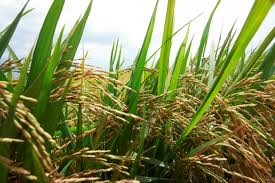Effect of nitrogen source and water management on rice yield and nitrogen use efficiency
Keywords:
Nitrogen source, N use efficiency, Prilled urea, Rice, Urea super granule, Water stressAbstract
We conducted two experiments usingprilled urea and urea super granule to examine the effects of nitrogen sourceand water stress on rice yield and nitrogen use efficiency. The experimentaltreatments were 0, 25, 50, 75 and 100 kg N ha-1 (experiment 1). Thewater stress treatments were: no fertilizer + continuous standing water, waterstress before first urea top dress, water stress before second urea top dress,water stress before third urea top dress, water stress before first, second andthird urea top dress and all fertilizers+continuousstanding water (experiment 2). The experiment was laid out in a randomizedcomplete block design with four replications. BRRI dhan49 was used as plantingmaterial. Urea super granule at 75 kg N ha-1 was enough for riceproduction in aman season and save 25 kg N ha-1 which was equivalentto 55 kg urea. During application of prilled urea water stress before third topdress performed better than continuous standing water in terms of grain yieldand nitrogen use efficiency.
References
Bhuiyan, N.I., Miah, M.A.M., Ishaque, M., 1998. Research on USG: Findings and Future Research Areas and Recommendation. Paper Presented at the National Workshop on Urea super granules Technology held at BARC. Dhaka, Bangladesh., 25 June, 1998.
Bouman, B.A.M., Peng, S., Castan˜eda, A.R., Visperas, R.M., 2005. Yield and water use of irrigated tropical aerobic rice systems. Agric. Water Manage., 74, 87–105.
BRRI., 2008. Bangladesh Rice Research Institute. Adhunik Dhaner Chas. (In Bengali) BRRI. Gazipur., 1701. pp. 38-39.
Catchpoole, V. R., Oxenham, D. J., Happer, L. A., 1983. Transformation and recovery of urea applied to a grass pasture in southeastern. Queensland. Aust J. Exp. Agr. Anim. Hus. 23, 80-86.
Chowdhury, M.J.U., Sarker, A.U., Sarker, M.A.R., Kashem, M.A., 1993. Effect of variety and number of seedlings hill-1 on the yield and its components on late transplanted aman rice. Bangladesh J. Agril. Sci., 20(2), 311-316.
De Datta, S.K., 1978. Fertilizer management for efficient use in wet land rice cultivation, IRRI, Los Banos, Philippines., pp.671-701.
Dhane, S.S., Khadse, R.R., Patil, V.H., Sauant, N.K., 1989. Effect of deep placed USG with limited green manure on transplanted rice yield. Intl. Rice Res. Newsl., 14 (4), 31.
Jee, R.C., Mahapatra, A.K.I., 1989. Effect of time of application of some slow release N-fertilizers on rice., Indian J. Agron., 34(4), 435-436.
Jadav, B.S., Sahane, D.V., 1997. Fertilizer management for rainfed rice. J. Maharashtra Agril. Univ., 22(3), 371-372.
Mandal, S., Swamy, S.N., 2003. Effect of time of N application on yield and yield attributes of rice (Oryza sativa ) cultivars. Envt. Ecology., 21(2), 411-413.
Mikkelsen, D.S., De Datta S.K., Obcemea, W.N., 1978. Ammonia volatilization losses from flooded rice soils. Soil Sci. Soc. Am. J., 42,725-730.
Mohanty, S.K., Chakravorti, S.P., Bhadrachalam, A., 1989. Nitrogen balance studies in rice using 15 N-labelled urea and urea supergranules. J. Agric. Sci., 113 (1), 119-121.
Nommik, H., 1973. Assessment of volatilization loss ofammonia from surface applied urea on forest soil by 15N recovery. Plant Soil., 38, 589-603.
Parsi-Nejad, M., Yazdani, M., Razavipour, T., 2003. The study of water application efficiency of paddy fields (Case study, irrigation system network of Sepid Roud, Guilan). 11th Seminar of Iranian National Committee on Irrigation and Drainage. Tehran., PP. 111-120.
Pillai, K.G., 1981. Agronomic practices to improve the N use efficiency of rice. Fertil. News., 26 (2), 3-9.
Prashad, R., Singh, S. Prasad, M., Thomas, J., 1982. Increased efficiency of fertilizer nitrogen applied to rice through urea super granules. Paper presented at the seminar of Indians Farmers Fertilizers Co-operative Ltd. held at Bangalore during 27-28 May 1982. Indian J. Agril. Sci., 59 (3), 154-156.
Rama, S., Reddy, G., Reddy, K., 1989. Effect of levels and sources of nitrogen on rice. Indian J. Agron., 34 (3), 364-366.
Ramaswamy, S., Sankaran, S., Velu, V., Athmanathan, V., Rajagopal, T., 1987. Split application of slow release urea. Newsl. Intl. Rice Res. Inst., 12, 45.
Singh, B.K., Singh, R.P., 1986. Effect of modified urea materials on rainfed lowland transplanted rice and their residual effect on successding wheat crop. Indian J. Agron., 31(2), 198-200.
Singh, M., Yadav, D.S., 1985. Nitrogen use efficiency in rice. Fertil. News., 30, 17-23.
Singh, S.P., Singh, M.P., 1997. Response of dwarf rice cv. Joya to different rates, methods and forms of urea materials. Env. Ecol., 15(3), 612-613.
Tabbal, D.F., Bouman. B.A.M., Bhuiyan, S.I., Sibayan, E.B., Sattar, M.A., 2002. On-farm strategies for reducing water input in irrigated rice; case studies in the Philippines. Agric. Water Manage., 56, 93–112.

Published
How to Cite
Issue
Section
Copyright (c) 2013 M.A. A. Mamun, M. R. Islam, S. M. Shahidullah

This work is licensed under a Creative Commons Attribution-NonCommercial-NoDerivatives 4.0 International License.



